Food Service Management: Approaches, Principles, Strategies, and Analytical Tools
VerifiedAdded on 2023/06/13
|12
|3522
|484
AI Summary
This report discusses different methods of food supply chain, principles of procurement and sourcing procedure, tools to assist effective management methods along with ethical approaches to increase success and accomplish organisational objectives.
Contribute Materials
Your contribution can guide someone’s learning journey. Share your
documents today.
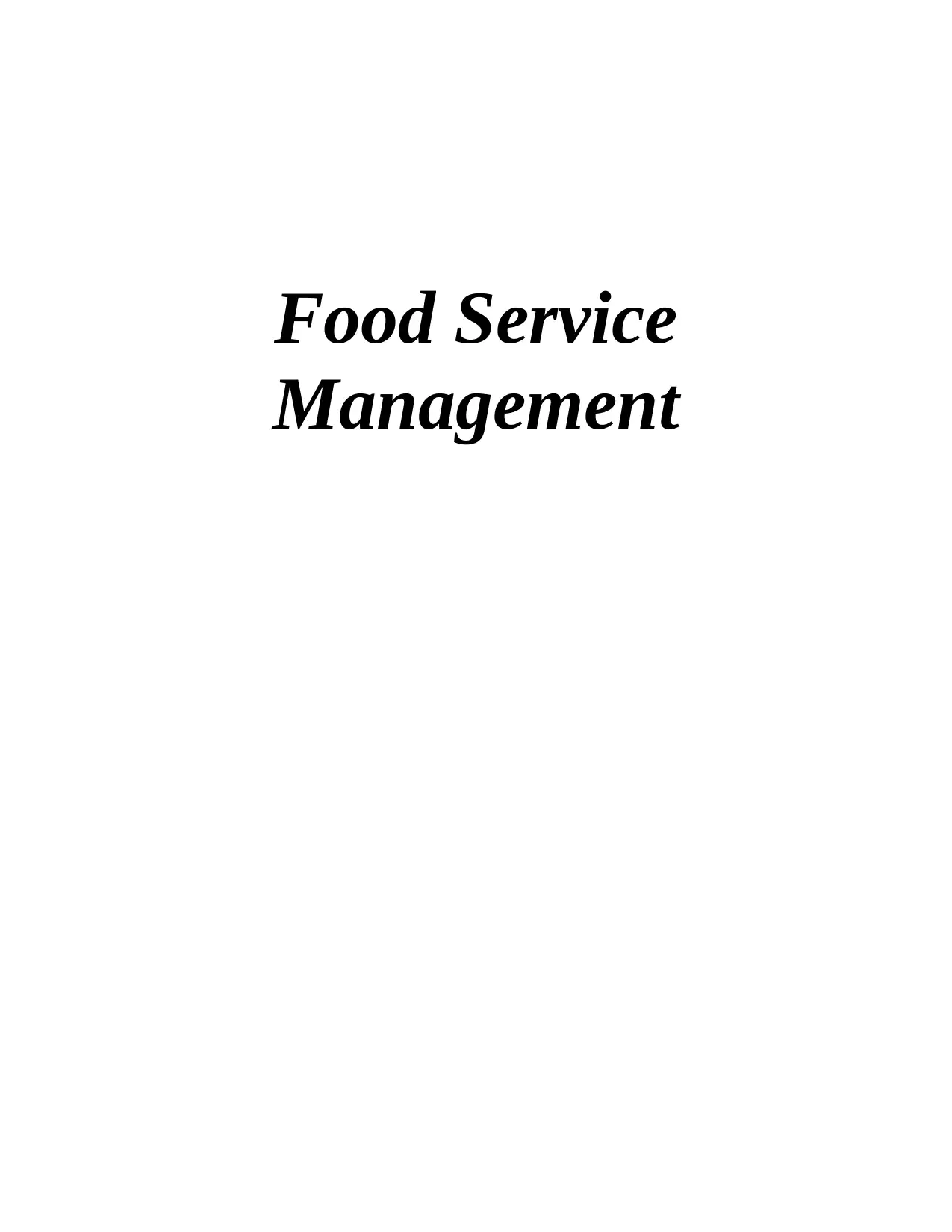
Food Service
Management
Management
Secure Best Marks with AI Grader
Need help grading? Try our AI Grader for instant feedback on your assignments.

Table of Contents
INTRODUCTION...........................................................................................................................1
MAIN BODY...................................................................................................................................1
Different food Supply Chain Approaches..............................................................................1
Principles of effective procurement and sourcing procedures ..............................................2
Food Supply Chain Approaches and Procurement Strategies ...............................................4
Analytical tools to support effective management strategies.................................................6
Management practices that support business operation in The Fat Duck..............................7
Ethical approaches in The Fat Duck and its impression on entire business success .............8
Strategies to enhance effective business operation................................................................8
Ethical Practices in The Fat Duck and its impact over the organisational objectives. ..........8
CONCLUSION................................................................................................................................9
REFERENCES..............................................................................................................................10
INTRODUCTION...........................................................................................................................1
MAIN BODY...................................................................................................................................1
Different food Supply Chain Approaches..............................................................................1
Principles of effective procurement and sourcing procedures ..............................................2
Food Supply Chain Approaches and Procurement Strategies ...............................................4
Analytical tools to support effective management strategies.................................................6
Management practices that support business operation in The Fat Duck..............................7
Ethical approaches in The Fat Duck and its impression on entire business success .............8
Strategies to enhance effective business operation................................................................8
Ethical Practices in The Fat Duck and its impact over the organisational objectives. ..........8
CONCLUSION................................................................................................................................9
REFERENCES..............................................................................................................................10

INTRODUCTION
Food facilities involve business, organisations and institutions that are accountable for
making food from external sources. The procedure of food facilities that mainly involve buying
raw materials, checking inventory, food preparation and many other activities. Food service
management is termed as procedure of serving different types of food and beverages to potential
customers in scientific and effective manner (Hennchen, 2019). These services also help in
improving profitability and productivity by training employees about serving and preparing food,
sourcing various suppliers as well as supervising inventory. The following report contains
different methods of food supply chain, principles of procurement as well as sourcing procedure,
tools to assist effective management methods along with ethical approaches to increase success
and accomplish organisational objectives. The restaurant which is chosen to complete this report
is The Fat Duck which is a dine restaurant in Bray, Berkshire, England and was established in
the year 1995 by celebrity chef Heston Blumenthal.
MAIN BODY
Different food Supply Chain Approaches
The various food supply chain approaches could become wider if members are involving
and can become clipped if any manufacturer trade products or services directly to consumers.
Efficiency of supply chain is evaluating by determining performance of a company that is
included in chain. The different supply chain approaches of food supply chain are explained
below:
Farmers:
Framers are considered as one of the approach of food supply chain and are potential
source for following food safety. They utilise synthetic and natural chemicals in order to save
crops and avoid damage of food from disease as well as animals (Kim, Kim and Park, 2020). The
Fat Duck gather its raw material from farmers so that the restaurant could serve quality food to
its customers. During this procedure different nature of commodities could impact quality of
harvested items. In the present time demands of organic food items has been increased by
customers as they are concern towards their health. Because of COVID-19, people focus on
preferring organic food items that are being produced through natural farming methods. The Fat
1
Food facilities involve business, organisations and institutions that are accountable for
making food from external sources. The procedure of food facilities that mainly involve buying
raw materials, checking inventory, food preparation and many other activities. Food service
management is termed as procedure of serving different types of food and beverages to potential
customers in scientific and effective manner (Hennchen, 2019). These services also help in
improving profitability and productivity by training employees about serving and preparing food,
sourcing various suppliers as well as supervising inventory. The following report contains
different methods of food supply chain, principles of procurement as well as sourcing procedure,
tools to assist effective management methods along with ethical approaches to increase success
and accomplish organisational objectives. The restaurant which is chosen to complete this report
is The Fat Duck which is a dine restaurant in Bray, Berkshire, England and was established in
the year 1995 by celebrity chef Heston Blumenthal.
MAIN BODY
Different food Supply Chain Approaches
The various food supply chain approaches could become wider if members are involving
and can become clipped if any manufacturer trade products or services directly to consumers.
Efficiency of supply chain is evaluating by determining performance of a company that is
included in chain. The different supply chain approaches of food supply chain are explained
below:
Farmers:
Framers are considered as one of the approach of food supply chain and are potential
source for following food safety. They utilise synthetic and natural chemicals in order to save
crops and avoid damage of food from disease as well as animals (Kim, Kim and Park, 2020). The
Fat Duck gather its raw material from farmers so that the restaurant could serve quality food to
its customers. During this procedure different nature of commodities could impact quality of
harvested items. In the present time demands of organic food items has been increased by
customers as they are concern towards their health. Because of COVID-19, people focus on
preferring organic food items that are being produced through natural farming methods. The Fat
1
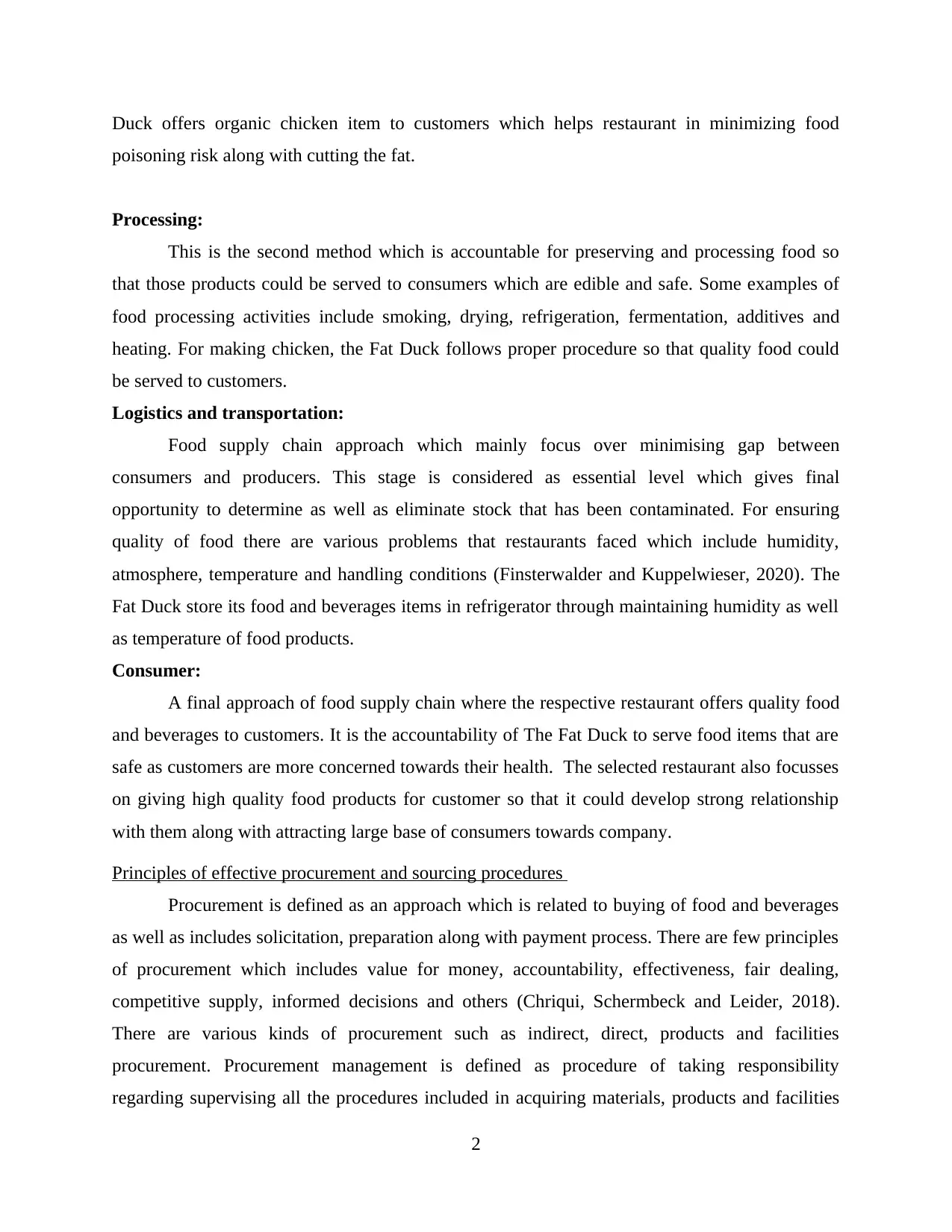
Duck offers organic chicken item to customers which helps restaurant in minimizing food
poisoning risk along with cutting the fat.
Processing:
This is the second method which is accountable for preserving and processing food so
that those products could be served to consumers which are edible and safe. Some examples of
food processing activities include smoking, drying, refrigeration, fermentation, additives and
heating. For making chicken, the Fat Duck follows proper procedure so that quality food could
be served to customers.
Logistics and transportation:
Food supply chain approach which mainly focus over minimising gap between
consumers and producers. This stage is considered as essential level which gives final
opportunity to determine as well as eliminate stock that has been contaminated. For ensuring
quality of food there are various problems that restaurants faced which include humidity,
atmosphere, temperature and handling conditions (Finsterwalder and Kuppelwieser, 2020). The
Fat Duck store its food and beverages items in refrigerator through maintaining humidity as well
as temperature of food products.
Consumer:
A final approach of food supply chain where the respective restaurant offers quality food
and beverages to customers. It is the accountability of The Fat Duck to serve food items that are
safe as customers are more concerned towards their health. The selected restaurant also focusses
on giving high quality food products for customer so that it could develop strong relationship
with them along with attracting large base of consumers towards company.
Principles of effective procurement and sourcing procedures
Procurement is defined as an approach which is related to buying of food and beverages
as well as includes solicitation, preparation along with payment process. There are few principles
of procurement which includes value for money, accountability, effectiveness, fair dealing,
competitive supply, informed decisions and others (Chriqui, Schermbeck and Leider, 2018).
There are various kinds of procurement such as indirect, direct, products and facilities
procurement. Procurement management is defined as procedure of taking responsibility
regarding supervising all the procedures included in acquiring materials, products and facilities
2
poisoning risk along with cutting the fat.
Processing:
This is the second method which is accountable for preserving and processing food so
that those products could be served to consumers which are edible and safe. Some examples of
food processing activities include smoking, drying, refrigeration, fermentation, additives and
heating. For making chicken, the Fat Duck follows proper procedure so that quality food could
be served to customers.
Logistics and transportation:
Food supply chain approach which mainly focus over minimising gap between
consumers and producers. This stage is considered as essential level which gives final
opportunity to determine as well as eliminate stock that has been contaminated. For ensuring
quality of food there are various problems that restaurants faced which include humidity,
atmosphere, temperature and handling conditions (Finsterwalder and Kuppelwieser, 2020). The
Fat Duck store its food and beverages items in refrigerator through maintaining humidity as well
as temperature of food products.
Consumer:
A final approach of food supply chain where the respective restaurant offers quality food
and beverages to customers. It is the accountability of The Fat Duck to serve food items that are
safe as customers are more concerned towards their health. The selected restaurant also focusses
on giving high quality food products for customer so that it could develop strong relationship
with them along with attracting large base of consumers towards company.
Principles of effective procurement and sourcing procedures
Procurement is defined as an approach which is related to buying of food and beverages
as well as includes solicitation, preparation along with payment process. There are few principles
of procurement which includes value for money, accountability, effectiveness, fair dealing,
competitive supply, informed decisions and others (Chriqui, Schermbeck and Leider, 2018).
There are various kinds of procurement such as indirect, direct, products and facilities
procurement. Procurement management is defined as procedure of taking responsibility
regarding supervising all the procedures included in acquiring materials, products and facilities
2
Secure Best Marks with AI Grader
Need help grading? Try our AI Grader for instant feedback on your assignments.
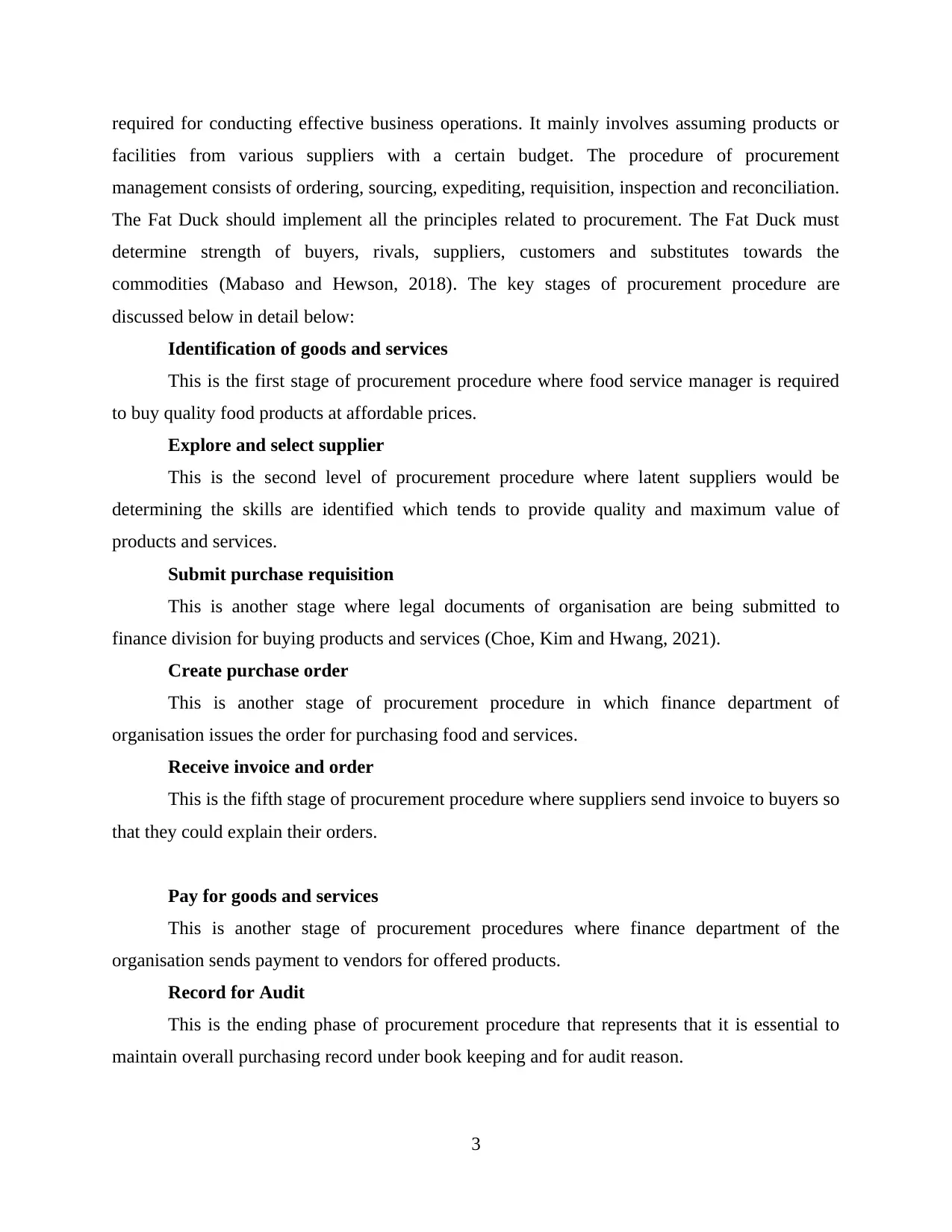
required for conducting effective business operations. It mainly involves assuming products or
facilities from various suppliers with a certain budget. The procedure of procurement
management consists of ordering, sourcing, expediting, requisition, inspection and reconciliation.
The Fat Duck should implement all the principles related to procurement. The Fat Duck must
determine strength of buyers, rivals, suppliers, customers and substitutes towards the
commodities (Mabaso and Hewson, 2018). The key stages of procurement procedure are
discussed below in detail below:
Identification of goods and services
This is the first stage of procurement procedure where food service manager is required
to buy quality food products at affordable prices.
Explore and select supplier
This is the second level of procurement procedure where latent suppliers would be
determining the skills are identified which tends to provide quality and maximum value of
products and services.
Submit purchase requisition
This is another stage where legal documents of organisation are being submitted to
finance division for buying products and services (Choe, Kim and Hwang, 2021).
Create purchase order
This is another stage of procurement procedure in which finance department of
organisation issues the order for purchasing food and services.
Receive invoice and order
This is the fifth stage of procurement procedure where suppliers send invoice to buyers so
that they could explain their orders.
Pay for goods and services
This is another stage of procurement procedures where finance department of the
organisation sends payment to vendors for offered products.
Record for Audit
This is the ending phase of procurement procedure that represents that it is essential to
maintain overall purchasing record under book keeping and for audit reason.
3
facilities from various suppliers with a certain budget. The procedure of procurement
management consists of ordering, sourcing, expediting, requisition, inspection and reconciliation.
The Fat Duck should implement all the principles related to procurement. The Fat Duck must
determine strength of buyers, rivals, suppliers, customers and substitutes towards the
commodities (Mabaso and Hewson, 2018). The key stages of procurement procedure are
discussed below in detail below:
Identification of goods and services
This is the first stage of procurement procedure where food service manager is required
to buy quality food products at affordable prices.
Explore and select supplier
This is the second level of procurement procedure where latent suppliers would be
determining the skills are identified which tends to provide quality and maximum value of
products and services.
Submit purchase requisition
This is another stage where legal documents of organisation are being submitted to
finance division for buying products and services (Choe, Kim and Hwang, 2021).
Create purchase order
This is another stage of procurement procedure in which finance department of
organisation issues the order for purchasing food and services.
Receive invoice and order
This is the fifth stage of procurement procedure where suppliers send invoice to buyers so
that they could explain their orders.
Pay for goods and services
This is another stage of procurement procedures where finance department of the
organisation sends payment to vendors for offered products.
Record for Audit
This is the ending phase of procurement procedure that represents that it is essential to
maintain overall purchasing record under book keeping and for audit reason.
3
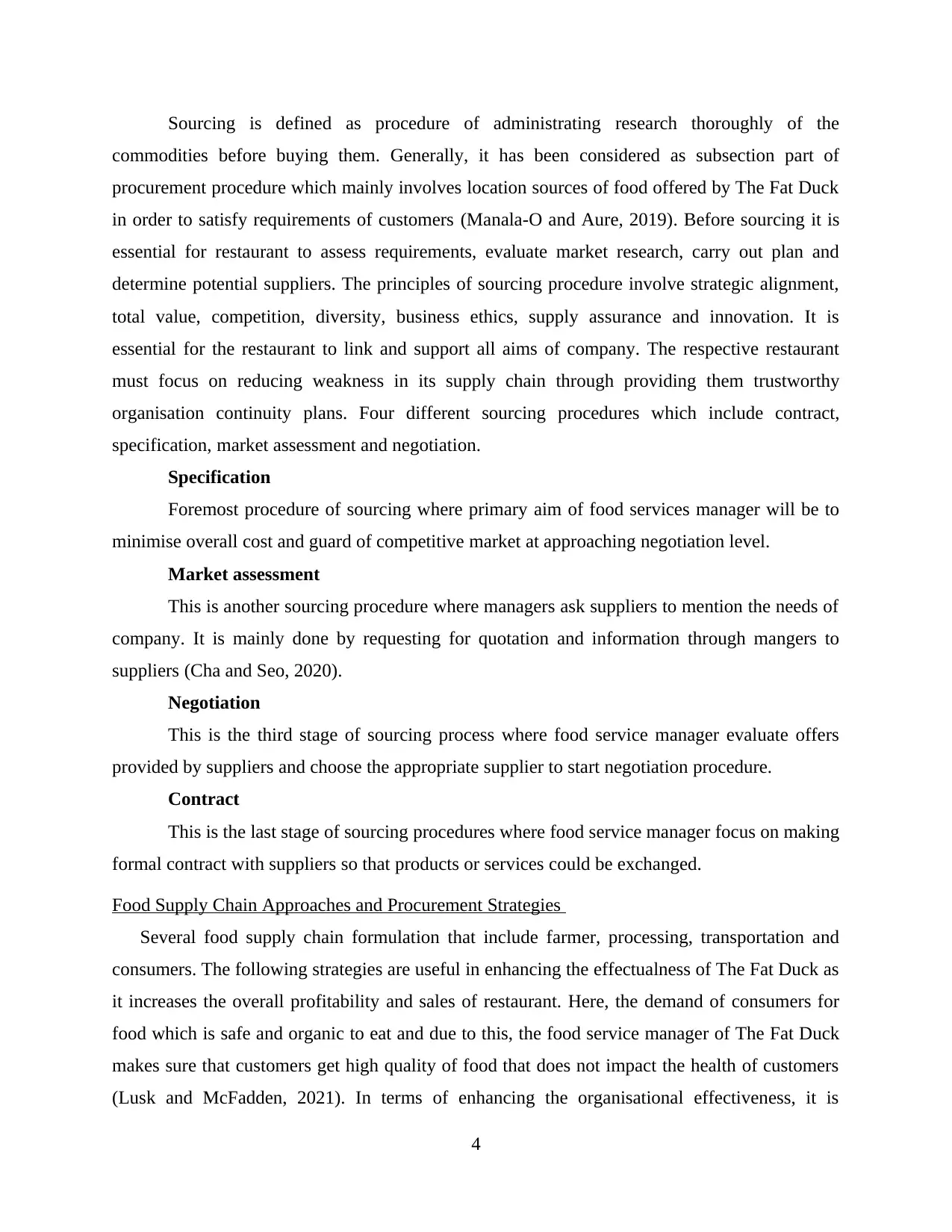
Sourcing is defined as procedure of administrating research thoroughly of the
commodities before buying them. Generally, it has been considered as subsection part of
procurement procedure which mainly involves location sources of food offered by The Fat Duck
in order to satisfy requirements of customers (Manala-O and Aure, 2019). Before sourcing it is
essential for restaurant to assess requirements, evaluate market research, carry out plan and
determine potential suppliers. The principles of sourcing procedure involve strategic alignment,
total value, competition, diversity, business ethics, supply assurance and innovation. It is
essential for the restaurant to link and support all aims of company. The respective restaurant
must focus on reducing weakness in its supply chain through providing them trustworthy
organisation continuity plans. Four different sourcing procedures which include contract,
specification, market assessment and negotiation.
Specification
Foremost procedure of sourcing where primary aim of food services manager will be to
minimise overall cost and guard of competitive market at approaching negotiation level.
Market assessment
This is another sourcing procedure where managers ask suppliers to mention the needs of
company. It is mainly done by requesting for quotation and information through mangers to
suppliers (Cha and Seo, 2020).
Negotiation
This is the third stage of sourcing process where food service manager evaluate offers
provided by suppliers and choose the appropriate supplier to start negotiation procedure.
Contract
This is the last stage of sourcing procedures where food service manager focus on making
formal contract with suppliers so that products or services could be exchanged.
Food Supply Chain Approaches and Procurement Strategies
Several food supply chain formulation that include farmer, processing, transportation and
consumers. The following strategies are useful in enhancing the effectualness of The Fat Duck as
it increases the overall profitability and sales of restaurant. Here, the demand of consumers for
food which is safe and organic to eat and due to this, the food service manager of The Fat Duck
makes sure that customers get high quality of food that does not impact the health of customers
(Lusk and McFadden, 2021). In terms of enhancing the organisational effectiveness, it is
4
commodities before buying them. Generally, it has been considered as subsection part of
procurement procedure which mainly involves location sources of food offered by The Fat Duck
in order to satisfy requirements of customers (Manala-O and Aure, 2019). Before sourcing it is
essential for restaurant to assess requirements, evaluate market research, carry out plan and
determine potential suppliers. The principles of sourcing procedure involve strategic alignment,
total value, competition, diversity, business ethics, supply assurance and innovation. It is
essential for the restaurant to link and support all aims of company. The respective restaurant
must focus on reducing weakness in its supply chain through providing them trustworthy
organisation continuity plans. Four different sourcing procedures which include contract,
specification, market assessment and negotiation.
Specification
Foremost procedure of sourcing where primary aim of food services manager will be to
minimise overall cost and guard of competitive market at approaching negotiation level.
Market assessment
This is another sourcing procedure where managers ask suppliers to mention the needs of
company. It is mainly done by requesting for quotation and information through mangers to
suppliers (Cha and Seo, 2020).
Negotiation
This is the third stage of sourcing process where food service manager evaluate offers
provided by suppliers and choose the appropriate supplier to start negotiation procedure.
Contract
This is the last stage of sourcing procedures where food service manager focus on making
formal contract with suppliers so that products or services could be exchanged.
Food Supply Chain Approaches and Procurement Strategies
Several food supply chain formulation that include farmer, processing, transportation and
consumers. The following strategies are useful in enhancing the effectualness of The Fat Duck as
it increases the overall profitability and sales of restaurant. Here, the demand of consumers for
food which is safe and organic to eat and due to this, the food service manager of The Fat Duck
makes sure that customers get high quality of food that does not impact the health of customers
(Lusk and McFadden, 2021). In terms of enhancing the organisational effectiveness, it is
4
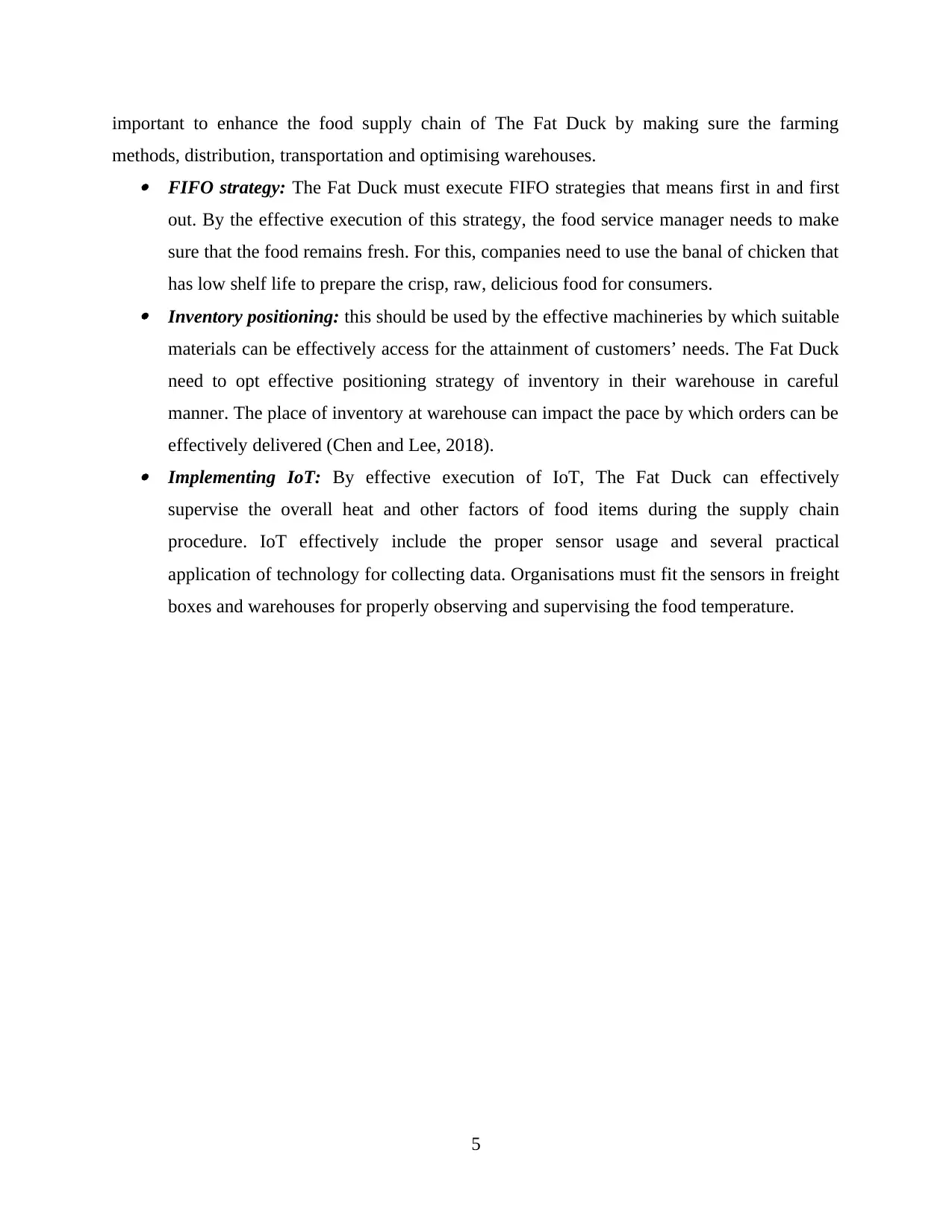
important to enhance the food supply chain of The Fat Duck by making sure the farming
methods, distribution, transportation and optimising warehouses. FIFO strategy: The Fat Duck must execute FIFO strategies that means first in and first
out. By the effective execution of this strategy, the food service manager needs to make
sure that the food remains fresh. For this, companies need to use the banal of chicken that
has low shelf life to prepare the crisp, raw, delicious food for consumers. Inventory positioning: this should be used by the effective machineries by which suitable
materials can be effectively access for the attainment of customers’ needs. The Fat Duck
need to opt effective positioning strategy of inventory in their warehouse in careful
manner. The place of inventory at warehouse can impact the pace by which orders can be
effectively delivered (Chen and Lee, 2018). Implementing IoT: By effective execution of IoT, The Fat Duck can effectively
supervise the overall heat and other factors of food items during the supply chain
procedure. IoT effectively include the proper sensor usage and several practical
application of technology for collecting data. Organisations must fit the sensors in freight
boxes and warehouses for properly observing and supervising the food temperature.
5
methods, distribution, transportation and optimising warehouses. FIFO strategy: The Fat Duck must execute FIFO strategies that means first in and first
out. By the effective execution of this strategy, the food service manager needs to make
sure that the food remains fresh. For this, companies need to use the banal of chicken that
has low shelf life to prepare the crisp, raw, delicious food for consumers. Inventory positioning: this should be used by the effective machineries by which suitable
materials can be effectively access for the attainment of customers’ needs. The Fat Duck
need to opt effective positioning strategy of inventory in their warehouse in careful
manner. The place of inventory at warehouse can impact the pace by which orders can be
effectively delivered (Chen and Lee, 2018). Implementing IoT: By effective execution of IoT, The Fat Duck can effectively
supervise the overall heat and other factors of food items during the supply chain
procedure. IoT effectively include the proper sensor usage and several practical
application of technology for collecting data. Organisations must fit the sensors in freight
boxes and warehouses for properly observing and supervising the food temperature.
5
Paraphrase This Document
Need a fresh take? Get an instant paraphrase of this document with our AI Paraphraser
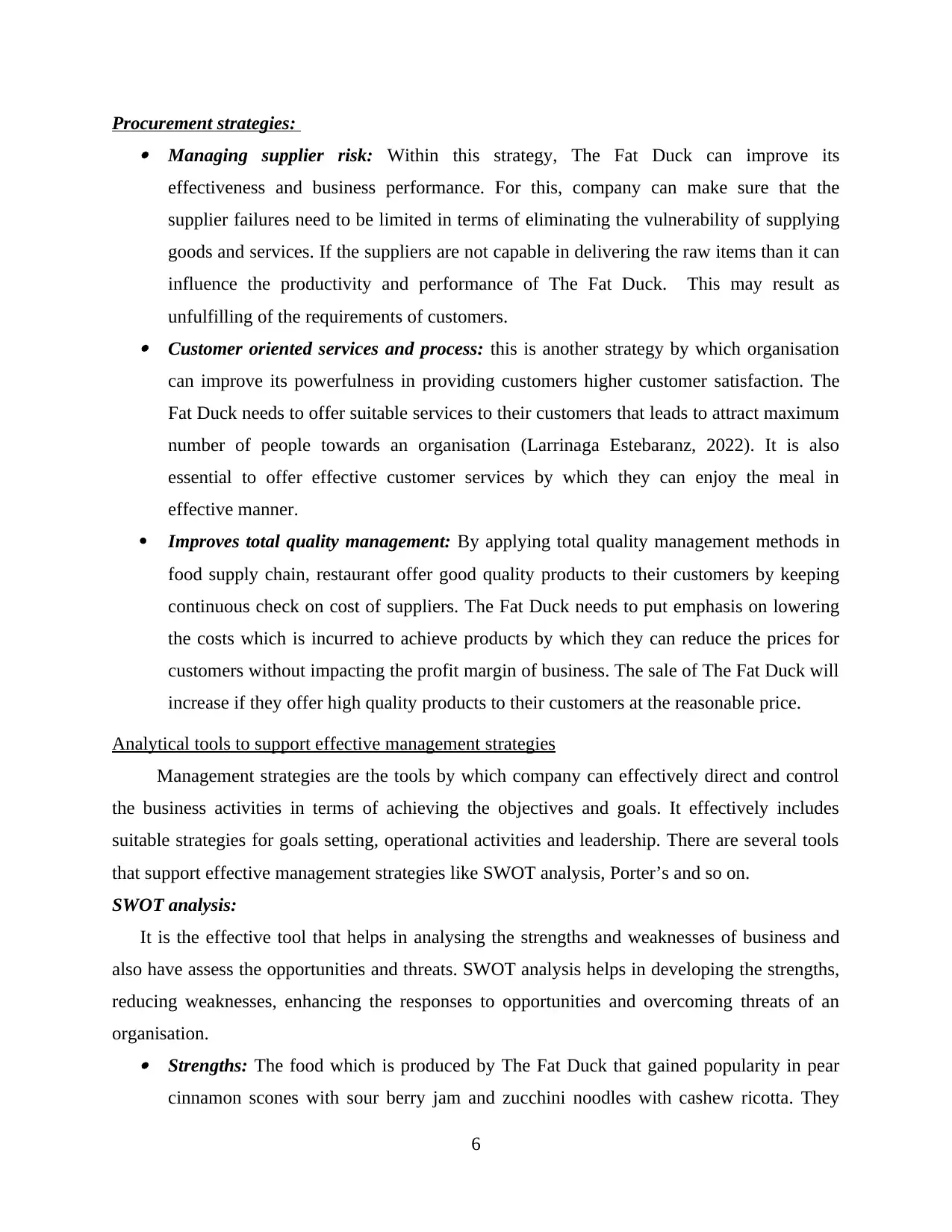
Procurement strategies: Managing supplier risk: Within this strategy, The Fat Duck can improve its
effectiveness and business performance. For this, company can make sure that the
supplier failures need to be limited in terms of eliminating the vulnerability of supplying
goods and services. If the suppliers are not capable in delivering the raw items than it can
influence the productivity and performance of The Fat Duck. This may result as
unfulfilling of the requirements of customers. Customer oriented services and process: this is another strategy by which organisation
can improve its powerfulness in providing customers higher customer satisfaction. The
Fat Duck needs to offer suitable services to their customers that leads to attract maximum
number of people towards an organisation (Larrinaga Estebaranz, 2022). It is also
essential to offer effective customer services by which they can enjoy the meal in
effective manner.
Improves total quality management: By applying total quality management methods in
food supply chain, restaurant offer good quality products to their customers by keeping
continuous check on cost of suppliers. The Fat Duck needs to put emphasis on lowering
the costs which is incurred to achieve products by which they can reduce the prices for
customers without impacting the profit margin of business. The sale of The Fat Duck will
increase if they offer high quality products to their customers at the reasonable price.
Analytical tools to support effective management strategies
Management strategies are the tools by which company can effectively direct and control
the business activities in terms of achieving the objectives and goals. It effectively includes
suitable strategies for goals setting, operational activities and leadership. There are several tools
that support effective management strategies like SWOT analysis, Porter’s and so on.
SWOT analysis:
It is the effective tool that helps in analysing the strengths and weaknesses of business and
also have assess the opportunities and threats. SWOT analysis helps in developing the strengths,
reducing weaknesses, enhancing the responses to opportunities and overcoming threats of an
organisation. Strengths: The food which is produced by The Fat Duck that gained popularity in pear
cinnamon scones with sour berry jam and zucchini noodles with cashew ricotta. They
6
effectiveness and business performance. For this, company can make sure that the
supplier failures need to be limited in terms of eliminating the vulnerability of supplying
goods and services. If the suppliers are not capable in delivering the raw items than it can
influence the productivity and performance of The Fat Duck. This may result as
unfulfilling of the requirements of customers. Customer oriented services and process: this is another strategy by which organisation
can improve its powerfulness in providing customers higher customer satisfaction. The
Fat Duck needs to offer suitable services to their customers that leads to attract maximum
number of people towards an organisation (Larrinaga Estebaranz, 2022). It is also
essential to offer effective customer services by which they can enjoy the meal in
effective manner.
Improves total quality management: By applying total quality management methods in
food supply chain, restaurant offer good quality products to their customers by keeping
continuous check on cost of suppliers. The Fat Duck needs to put emphasis on lowering
the costs which is incurred to achieve products by which they can reduce the prices for
customers without impacting the profit margin of business. The sale of The Fat Duck will
increase if they offer high quality products to their customers at the reasonable price.
Analytical tools to support effective management strategies
Management strategies are the tools by which company can effectively direct and control
the business activities in terms of achieving the objectives and goals. It effectively includes
suitable strategies for goals setting, operational activities and leadership. There are several tools
that support effective management strategies like SWOT analysis, Porter’s and so on.
SWOT analysis:
It is the effective tool that helps in analysing the strengths and weaknesses of business and
also have assess the opportunities and threats. SWOT analysis helps in developing the strengths,
reducing weaknesses, enhancing the responses to opportunities and overcoming threats of an
organisation. Strengths: The food which is produced by The Fat Duck that gained popularity in pear
cinnamon scones with sour berry jam and zucchini noodles with cashew ricotta. They
6
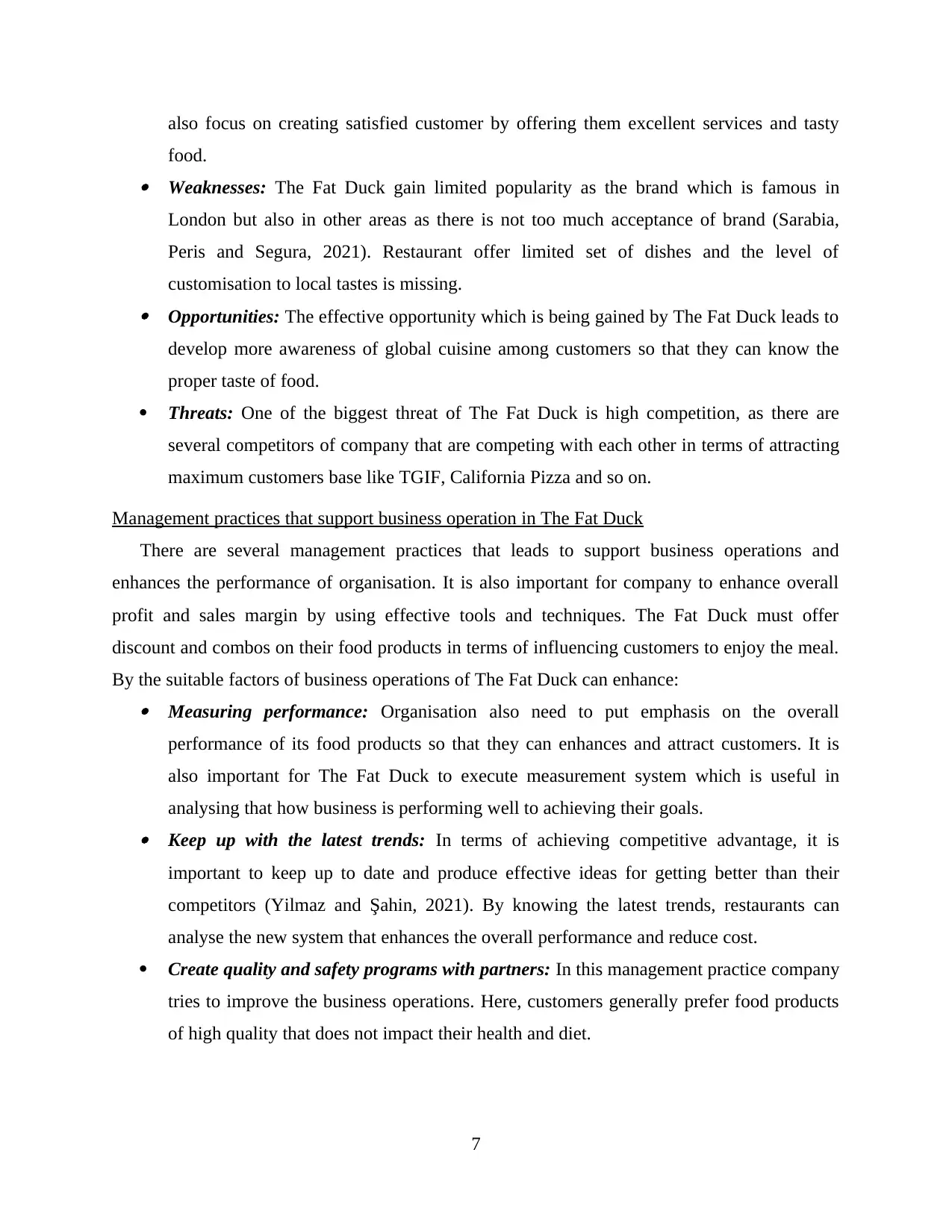
also focus on creating satisfied customer by offering them excellent services and tasty
food. Weaknesses: The Fat Duck gain limited popularity as the brand which is famous in
London but also in other areas as there is not too much acceptance of brand (Sarabia,
Peris and Segura, 2021). Restaurant offer limited set of dishes and the level of
customisation to local tastes is missing. Opportunities: The effective opportunity which is being gained by The Fat Duck leads to
develop more awareness of global cuisine among customers so that they can know the
proper taste of food.
Threats: One of the biggest threat of The Fat Duck is high competition, as there are
several competitors of company that are competing with each other in terms of attracting
maximum customers base like TGIF, California Pizza and so on.
Management practices that support business operation in The Fat Duck
There are several management practices that leads to support business operations and
enhances the performance of organisation. It is also important for company to enhance overall
profit and sales margin by using effective tools and techniques. The Fat Duck must offer
discount and combos on their food products in terms of influencing customers to enjoy the meal.
By the suitable factors of business operations of The Fat Duck can enhance: Measuring performance: Organisation also need to put emphasis on the overall
performance of its food products so that they can enhances and attract customers. It is
also important for The Fat Duck to execute measurement system which is useful in
analysing that how business is performing well to achieving their goals. Keep up with the latest trends: In terms of achieving competitive advantage, it is
important to keep up to date and produce effective ideas for getting better than their
competitors (Yilmaz and Şahin, 2021). By knowing the latest trends, restaurants can
analyse the new system that enhances the overall performance and reduce cost.
Create quality and safety programs with partners: In this management practice company
tries to improve the business operations. Here, customers generally prefer food products
of high quality that does not impact their health and diet.
7
food. Weaknesses: The Fat Duck gain limited popularity as the brand which is famous in
London but also in other areas as there is not too much acceptance of brand (Sarabia,
Peris and Segura, 2021). Restaurant offer limited set of dishes and the level of
customisation to local tastes is missing. Opportunities: The effective opportunity which is being gained by The Fat Duck leads to
develop more awareness of global cuisine among customers so that they can know the
proper taste of food.
Threats: One of the biggest threat of The Fat Duck is high competition, as there are
several competitors of company that are competing with each other in terms of attracting
maximum customers base like TGIF, California Pizza and so on.
Management practices that support business operation in The Fat Duck
There are several management practices that leads to support business operations and
enhances the performance of organisation. It is also important for company to enhance overall
profit and sales margin by using effective tools and techniques. The Fat Duck must offer
discount and combos on their food products in terms of influencing customers to enjoy the meal.
By the suitable factors of business operations of The Fat Duck can enhance: Measuring performance: Organisation also need to put emphasis on the overall
performance of its food products so that they can enhances and attract customers. It is
also important for The Fat Duck to execute measurement system which is useful in
analysing that how business is performing well to achieving their goals. Keep up with the latest trends: In terms of achieving competitive advantage, it is
important to keep up to date and produce effective ideas for getting better than their
competitors (Yilmaz and Şahin, 2021). By knowing the latest trends, restaurants can
analyse the new system that enhances the overall performance and reduce cost.
Create quality and safety programs with partners: In this management practice company
tries to improve the business operations. Here, customers generally prefer food products
of high quality that does not impact their health and diet.
7
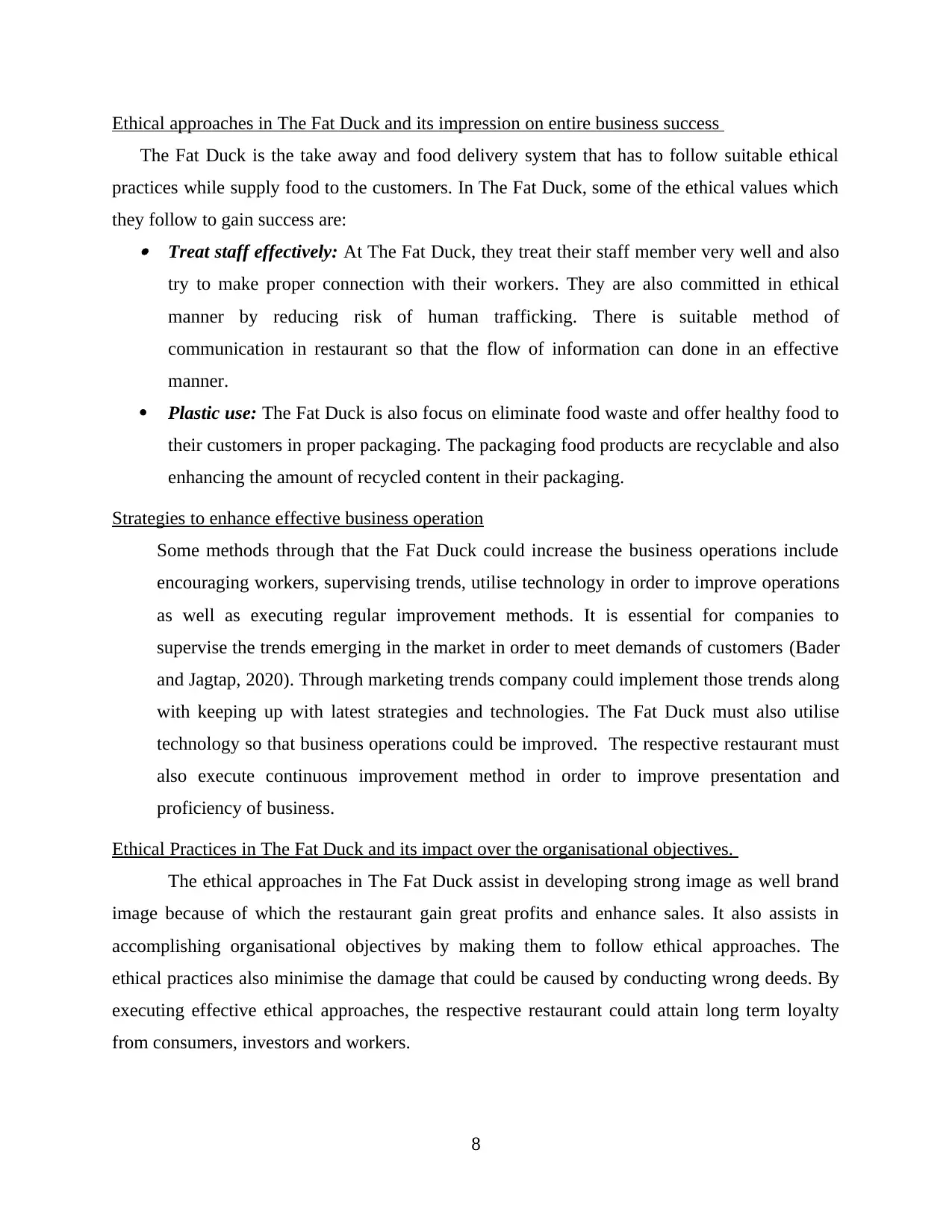
Ethical approaches in The Fat Duck and its impression on entire business success
The Fat Duck is the take away and food delivery system that has to follow suitable ethical
practices while supply food to the customers. In The Fat Duck, some of the ethical values which
they follow to gain success are: Treat staff effectively: At The Fat Duck, they treat their staff member very well and also
try to make proper connection with their workers. They are also committed in ethical
manner by reducing risk of human trafficking. There is suitable method of
communication in restaurant so that the flow of information can done in an effective
manner.
Plastic use: The Fat Duck is also focus on eliminate food waste and offer healthy food to
their customers in proper packaging. The packaging food products are recyclable and also
enhancing the amount of recycled content in their packaging.
Strategies to enhance effective business operation
Some methods through that the Fat Duck could increase the business operations include
encouraging workers, supervising trends, utilise technology in order to improve operations
as well as executing regular improvement methods. It is essential for companies to
supervise the trends emerging in the market in order to meet demands of customers (Bader
and Jagtap, 2020). Through marketing trends company could implement those trends along
with keeping up with latest strategies and technologies. The Fat Duck must also utilise
technology so that business operations could be improved. The respective restaurant must
also execute continuous improvement method in order to improve presentation and
proficiency of business.
Ethical Practices in The Fat Duck and its impact over the organisational objectives.
The ethical approaches in The Fat Duck assist in developing strong image as well brand
image because of which the restaurant gain great profits and enhance sales. It also assists in
accomplishing organisational objectives by making them to follow ethical approaches. The
ethical practices also minimise the damage that could be caused by conducting wrong deeds. By
executing effective ethical approaches, the respective restaurant could attain long term loyalty
from consumers, investors and workers.
8
The Fat Duck is the take away and food delivery system that has to follow suitable ethical
practices while supply food to the customers. In The Fat Duck, some of the ethical values which
they follow to gain success are: Treat staff effectively: At The Fat Duck, they treat their staff member very well and also
try to make proper connection with their workers. They are also committed in ethical
manner by reducing risk of human trafficking. There is suitable method of
communication in restaurant so that the flow of information can done in an effective
manner.
Plastic use: The Fat Duck is also focus on eliminate food waste and offer healthy food to
their customers in proper packaging. The packaging food products are recyclable and also
enhancing the amount of recycled content in their packaging.
Strategies to enhance effective business operation
Some methods through that the Fat Duck could increase the business operations include
encouraging workers, supervising trends, utilise technology in order to improve operations
as well as executing regular improvement methods. It is essential for companies to
supervise the trends emerging in the market in order to meet demands of customers (Bader
and Jagtap, 2020). Through marketing trends company could implement those trends along
with keeping up with latest strategies and technologies. The Fat Duck must also utilise
technology so that business operations could be improved. The respective restaurant must
also execute continuous improvement method in order to improve presentation and
proficiency of business.
Ethical Practices in The Fat Duck and its impact over the organisational objectives.
The ethical approaches in The Fat Duck assist in developing strong image as well brand
image because of which the restaurant gain great profits and enhance sales. It also assists in
accomplishing organisational objectives by making them to follow ethical approaches. The
ethical practices also minimise the damage that could be caused by conducting wrong deeds. By
executing effective ethical approaches, the respective restaurant could attain long term loyalty
from consumers, investors and workers.
8
Secure Best Marks with AI Grader
Need help grading? Try our AI Grader for instant feedback on your assignments.

CONCLUSION
It is understood from above discussion it has been determined that primary motive of
food and beverage services is to make as well as offer food to those consumers who are missing
their native places. There are various types of food facilities such as buffet, self-services, service
style and many more. The company could minimize the risk associated with failure of supply
chain through applying effective procurement procedures. Organisations could focus on
manufacturing high quality chicken meal for their customers so that large base of customers
towards their brand.
9
It is understood from above discussion it has been determined that primary motive of
food and beverage services is to make as well as offer food to those consumers who are missing
their native places. There are various types of food facilities such as buffet, self-services, service
style and many more. The company could minimize the risk associated with failure of supply
chain through applying effective procurement procedures. Organisations could focus on
manufacturing high quality chicken meal for their customers so that large base of customers
towards their brand.
9
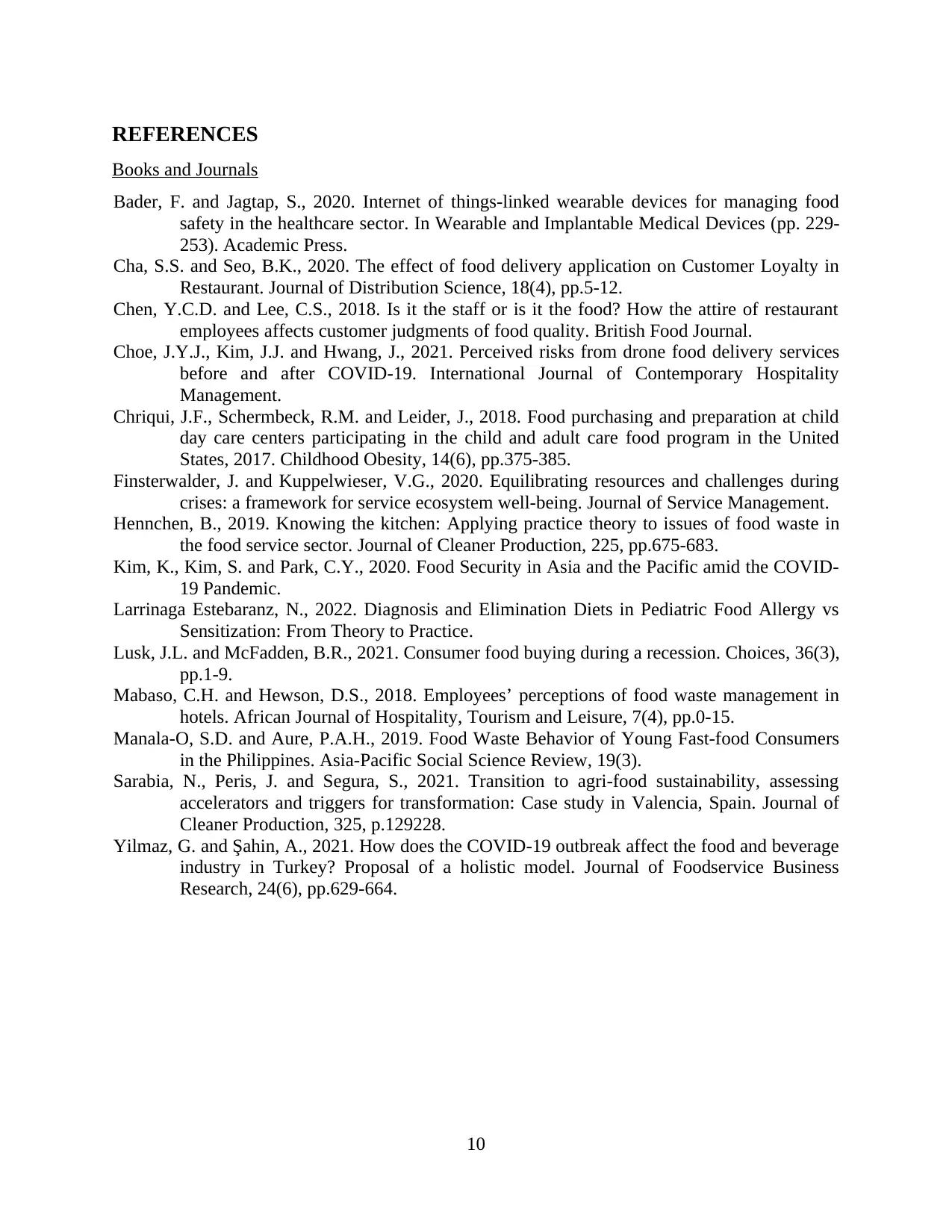
REFERENCES
Books and Journals
Bader, F. and Jagtap, S., 2020. Internet of things-linked wearable devices for managing food
safety in the healthcare sector. In Wearable and Implantable Medical Devices (pp. 229-
253). Academic Press.
Cha, S.S. and Seo, B.K., 2020. The effect of food delivery application on Customer Loyalty in
Restaurant. Journal of Distribution Science, 18(4), pp.5-12.
Chen, Y.C.D. and Lee, C.S., 2018. Is it the staff or is it the food? How the attire of restaurant
employees affects customer judgments of food quality. British Food Journal.
Choe, J.Y.J., Kim, J.J. and Hwang, J., 2021. Perceived risks from drone food delivery services
before and after COVID-19. International Journal of Contemporary Hospitality
Management.
Chriqui, J.F., Schermbeck, R.M. and Leider, J., 2018. Food purchasing and preparation at child
day care centers participating in the child and adult care food program in the United
States, 2017. Childhood Obesity, 14(6), pp.375-385.
Finsterwalder, J. and Kuppelwieser, V.G., 2020. Equilibrating resources and challenges during
crises: a framework for service ecosystem well-being. Journal of Service Management.
Hennchen, B., 2019. Knowing the kitchen: Applying practice theory to issues of food waste in
the food service sector. Journal of Cleaner Production, 225, pp.675-683.
Kim, K., Kim, S. and Park, C.Y., 2020. Food Security in Asia and the Pacific amid the COVID-
19 Pandemic.
Larrinaga Estebaranz, N., 2022. Diagnosis and Elimination Diets in Pediatric Food Allergy vs
Sensitization: From Theory to Practice.
Lusk, J.L. and McFadden, B.R., 2021. Consumer food buying during a recession. Choices, 36(3),
pp.1-9.
Mabaso, C.H. and Hewson, D.S., 2018. Employees’ perceptions of food waste management in
hotels. African Journal of Hospitality, Tourism and Leisure, 7(4), pp.0-15.
Manala-O, S.D. and Aure, P.A.H., 2019. Food Waste Behavior of Young Fast-food Consumers
in the Philippines. Asia-Pacific Social Science Review, 19(3).
Sarabia, N., Peris, J. and Segura, S., 2021. Transition to agri-food sustainability, assessing
accelerators and triggers for transformation: Case study in Valencia, Spain. Journal of
Cleaner Production, 325, p.129228.
Yilmaz, G. and Şahin, A., 2021. How does the COVID-19 outbreak affect the food and beverage
industry in Turkey? Proposal of a holistic model. Journal of Foodservice Business
Research, 24(6), pp.629-664.
10
Books and Journals
Bader, F. and Jagtap, S., 2020. Internet of things-linked wearable devices for managing food
safety in the healthcare sector. In Wearable and Implantable Medical Devices (pp. 229-
253). Academic Press.
Cha, S.S. and Seo, B.K., 2020. The effect of food delivery application on Customer Loyalty in
Restaurant. Journal of Distribution Science, 18(4), pp.5-12.
Chen, Y.C.D. and Lee, C.S., 2018. Is it the staff or is it the food? How the attire of restaurant
employees affects customer judgments of food quality. British Food Journal.
Choe, J.Y.J., Kim, J.J. and Hwang, J., 2021. Perceived risks from drone food delivery services
before and after COVID-19. International Journal of Contemporary Hospitality
Management.
Chriqui, J.F., Schermbeck, R.M. and Leider, J., 2018. Food purchasing and preparation at child
day care centers participating in the child and adult care food program in the United
States, 2017. Childhood Obesity, 14(6), pp.375-385.
Finsterwalder, J. and Kuppelwieser, V.G., 2020. Equilibrating resources and challenges during
crises: a framework for service ecosystem well-being. Journal of Service Management.
Hennchen, B., 2019. Knowing the kitchen: Applying practice theory to issues of food waste in
the food service sector. Journal of Cleaner Production, 225, pp.675-683.
Kim, K., Kim, S. and Park, C.Y., 2020. Food Security in Asia and the Pacific amid the COVID-
19 Pandemic.
Larrinaga Estebaranz, N., 2022. Diagnosis and Elimination Diets in Pediatric Food Allergy vs
Sensitization: From Theory to Practice.
Lusk, J.L. and McFadden, B.R., 2021. Consumer food buying during a recession. Choices, 36(3),
pp.1-9.
Mabaso, C.H. and Hewson, D.S., 2018. Employees’ perceptions of food waste management in
hotels. African Journal of Hospitality, Tourism and Leisure, 7(4), pp.0-15.
Manala-O, S.D. and Aure, P.A.H., 2019. Food Waste Behavior of Young Fast-food Consumers
in the Philippines. Asia-Pacific Social Science Review, 19(3).
Sarabia, N., Peris, J. and Segura, S., 2021. Transition to agri-food sustainability, assessing
accelerators and triggers for transformation: Case study in Valencia, Spain. Journal of
Cleaner Production, 325, p.129228.
Yilmaz, G. and Şahin, A., 2021. How does the COVID-19 outbreak affect the food and beverage
industry in Turkey? Proposal of a holistic model. Journal of Foodservice Business
Research, 24(6), pp.629-664.
10
1 out of 12
Related Documents
Your All-in-One AI-Powered Toolkit for Academic Success.
+13062052269
info@desklib.com
Available 24*7 on WhatsApp / Email
![[object Object]](/_next/static/media/star-bottom.7253800d.svg)
Unlock your academic potential
© 2024 | Zucol Services PVT LTD | All rights reserved.





